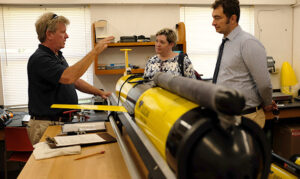Learning about BIOS

A BIOS glider used for undersea research in the Sargasso Sea was one focus of a tour of BIOS with London-based Kylie Bamford (center), head of marine conservation for the overseas territories within the Foreign and Commonwealth Office. Joining her was Barry Bobin-Martin (right), executive officer at Government House in Bermuda.
Bamford said she was very interested in the long-term deep-water data series collected by BIOS, particularly in relation to temperature fluctuations, which could be used to understand climate change. She also expressed interest in the BIOS-based Risk Prediction Initiative, “which could be invaluable to coastal areas susceptible to hurricanes and tropical storms,” she said.
Bamford leads the United Kingdom government’s “Blue Belt” program, which aims to deliver increases in the protection of marine biodiversity across the combined maritime zones of the United Kingdom and its overseas territories.
As part of this program, Bamford said that she and others in the government are facilitating access to technical expertise, practical surveillance, and technology solutions to ensure that protected maritime areas are backed up by robust scientific data, legislation, and enforcement.
BIOS president and CEO William Curry (left) lead the tour before departing for the Ocean Risk Summit, a three-day event on the island that brought together leaders to examine the challenges and risks posed by ocean change, and identify the opportunities for applied solutions.
